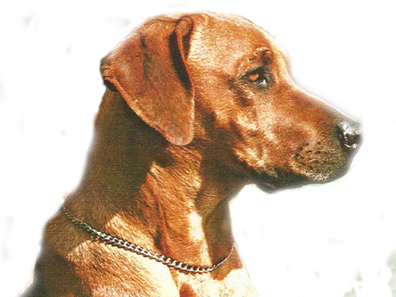The Rhodesian Ridgeback
Andrew Brace, on Your Dog, 2003
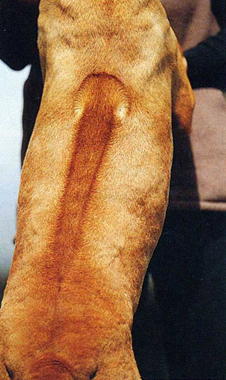
Although a relatively young ‘ breed compared with many i others, the Rhodesian i Ridgeback is proving increasingly popular as an intelligent companion and guard. His distinctive ridge A a line of hair with two crowns growing out of line with the body coat on the back — may be the ‘escutcheon’ of the breed but there is much more to this South African invader than merely is hair pattern. A medium to large dog, the Ridgeback is athletic in build, unexaggerated in form, and of stable, if somewhat aloof, temperament. He is built for endurance and is a naturally gregarious animal who njoys the company of both humans and other animals. His sleek coat makes him a low-maintenance breed as regards grooming, but he is an athlete who needs to lead an active life.
History
As recently as 1922, a group of enthusiastic dog owners, led by Francis Richard Barnes, gathered together in former Rhodesia to discuss the development of a breed of dog from indigenous ridged dogs. The ridge is undeniably a mutation and serves no practical purpose, but history relates that dogs bearing ridges of hair have also been found in Asia (presumably the ancestors of the Thai Ridgeback) and former Namibia. Cesar de Castro Martines, a Portuguese adventurer, wrote in detail of Kamussekele dogs who were the companions of the Khoikhoi people who inhabited the Namibian desert, and which carried distinctive ridges of hair on their backs. These dogs still exist and have been sighted within the past decade, and it is a reasonable assumption that they share a common ancestry with the mixed selection of ridged dogs which were brought together in the early 1920s.
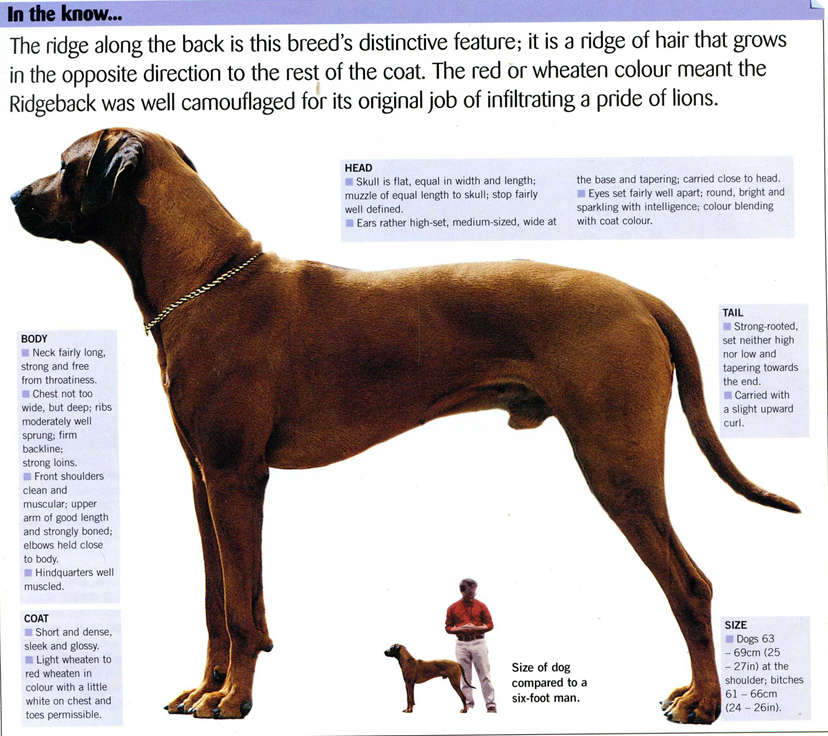
The prime objective in creating the Rhodesian Ridgeback was to produce a hunter’s dog. Much as the idea is distasteful in the 21st century, at this time the slaughter of wildlife, and notably the big cats, was considered acceptable ‘sport’ by the European upper classes, and southern Africa was a haven for explorers and hunters. One of the best-known hunters of the time was Frederick Courtney Selous and it is debatable whether he deliberately selected ridged dogs or if this was pure coincidence. However a later hunter, Cornelius van Rooyen, evidently did and the employed ridged dogs were for some time known as ‘Van Rooyen’s dogs’. Whether the ridged dogs were brought from the east or north is not really important, but they certainly existed in numbers when Barnes and his colleagues attempted to establish a special breed of dog. Prior to Barnes’ attempt to formalize the breeding of these dogs, ridged dogs had been used over a large area early in the 20th century as farm dogs; versatile, agile companion guards rather than hunters’ dogs.
The misconception among casual observers that the Ridgeback was developed to actually kill the lion is far from the truth. These courageous dogs were required to encircle the lion and execute a mock attack, the idea being that the cat would become distracted sufficiently for the hunter to position himself for the kill. What was required was a steady minded dog that was bold without being overly aggressive.
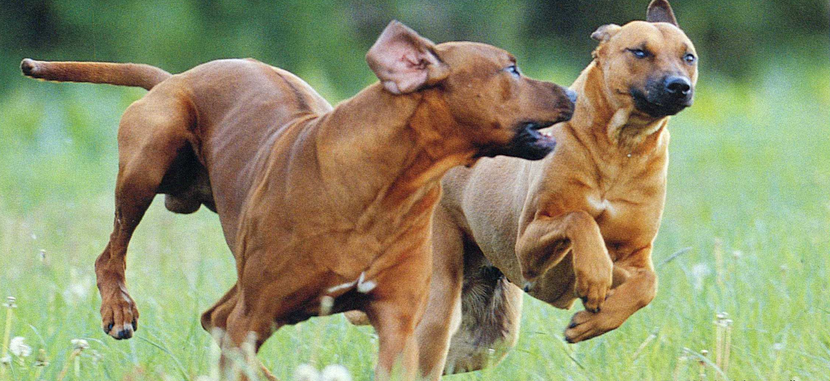
It was noted early on that the ridged dogs were remarkably swift and agile, and were naturally adept at avoiding the lion’s reaction. They were skilled in keeping the big game at bay for the hunter, and it is recorded that often the bitches, rather than the males, excelled in their agility.
To this day the Ridgeback’s heritage has not been ignored and the breed has been used for hunting cougar in the USA and elk in Scandinavia.
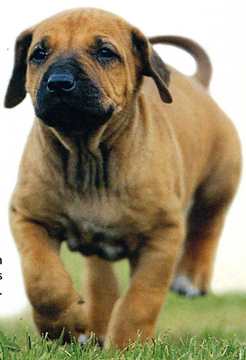
Youngsters should be exercized in the garden and on short lead walks to protect growing bones
With the intention of establishing some kind of conformity within the ridged dogs, Barnes and his colleagues used the written breed standard of the Dalmatian as a blueprint, and today it can clearly be seen that there are similarities within the shape of the two breeds. Initially the founding breeders were working with dogs of varying shapes and colours,- but it would be perfectly understandable that the red or wheaten colour would be ideal for a dog that was expected to work around lions, this being perfect for camouflage and easy infiltration of a pride.
Much thought went into the physical make-up of the Ridgeback and functionability and agility were obviously paramount.
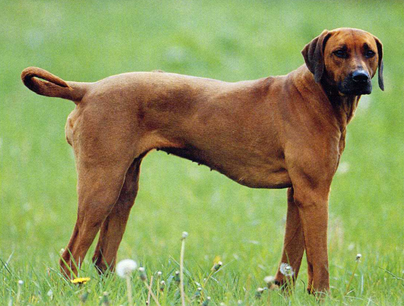
The ridgeback colour was perfect camouflage when infiltrating a pride of lions
The overall picture was to be of a fairly large dog, alert and proud, with almost an arrogant disinterest borne of a lack of dependence.
The body should be longer than the dog’s height, with angulation that was balanced and sufficient for long-distance running and sudden bursts of speed. Obviously flexibility was required, but so was substance a deep chest with sufficient forechest, strong bone and ribs that had moderate spring without becoming barreled and cumbersome.
The dog would need to be muscular and fit, and unexaggerated. His head would have sufficient width of skull to give brain room, the skull being equal in width and length and, further, the muzzle would be of equal length to the skull. The muzzle needed to be strong, deep and clean-lipped, with strong jaws, big teeth and a scissor bite. The ears should be fairly high set and carried close to the head, the eyes set well apart in the skull and sparkling with intelligence, in a colour blending with the coat.
Barnes and his fellows did a good job in fitting together the pieces of the jigsaw and soon the Rhodesian began to emerge. lt is claimed that a Ridgeback first arrived in Britain in 1914 i some years before the breed was actually recognized in its homeland — but the first to be seen at a British dog show were the two that were imported by Mrs John Player (of the famous tobacco family) and exhibited at The Kennel Club’s 1932 show at Crystal Palace. As Princess Elizabeth, our present Queen was presented with a brace of Ridgebacks when she visited South Africa in 1947.
This brought the breed to greater prominence in Britain and, while the bitch had sadly died in quarantine, the male — Just of Banba — was kept at the Sandringham kennels until his death in 1951. He was the sire of the first British champion in the breed, Maiduba of Mancross, who won his title in 1954 — appropriately at Windsor Show. On the occasions when he won his first two challenge certificates, it was his litter sister — Merill of Mancross — who won the bitch certificate but she had to wait until the following year before she could claim her championship.

In spite of all his natural courage, the Ridgeback can be a sensitive breed
Now Zimbabwe, Rhodesia has obviously had troubled times and the present day does not make it easy for dog breeders in the country. The parent club has also had difficulties since its formation in 1922, but in 1997 staged its own championship show for the first time; the honour of judging it went to Jack Selby of the Eilack kennel in the UK, one of the breed’s longest-sen/ing and most dedicated supporters. Originally the breed was classified as a Gundog, but in 1949 it was transferred to the Hound group which was deemed more appropriate. Around the world it appears in this group where it competes with Afghans, Dachshunds and Whippets, frequently with great success. In the UK alone the breed has risen to the heights of Best in Show All Breeds at championship level, so in a relatively short space of time the Rhodesian Ridgeback can be considered something of a success story.
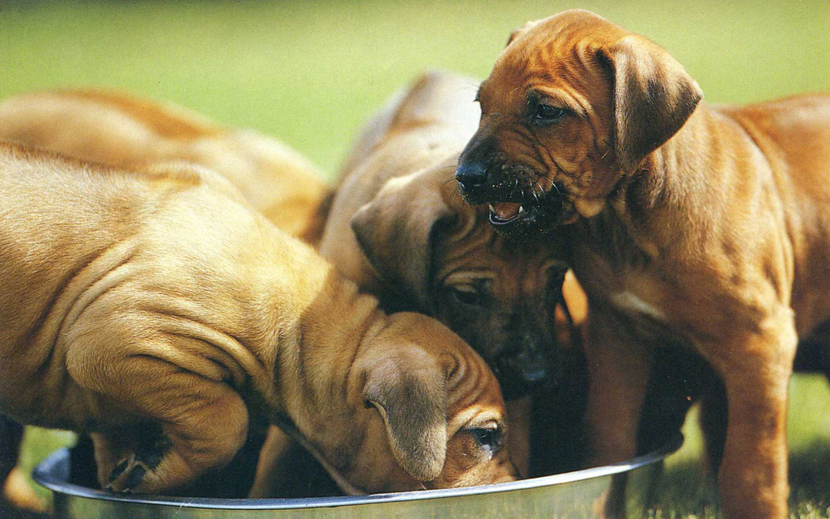
Any Ridgeback owner needs to build up a trusting relationship with his new pup; this isn’t a breed to respond to drill-like commands.
Temperament and character
The key word describing the Ridgeback’s character is probably pride — no leonine pun intended! The breed is self-assured, confident and knows its own speed, agility and limitations. Specialists have used a variety of terms to explain the Ridgeback’s mental complexities alert, arrogant, conflict-shy, devoted, independent and self-sustained have all been used. All have some elemen of accuracy.
Place the Ridgeback in certain situations and his heritage can easily surface. It has been recorded that this is a great tracking dog, tracking both by air and ground contact; the Ridgeback will frequently instinctively herd other animals into a tight group simply by circling them; his guarding instincts can be accompanying his master, he will visibly make a decision how to react, sometimes by encouraging his master to move away, or by circling behind approaching ‘enemies’ with the intention of dispersing them.
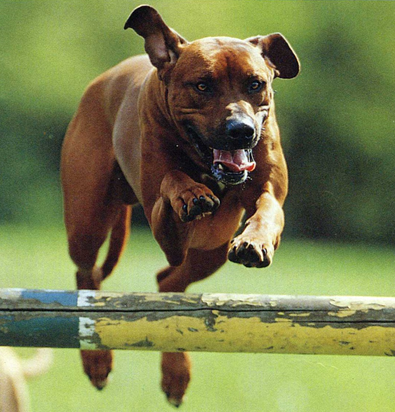
Agility is an ideal means of maintaining your Ridgeback’s fitness and keeping him mentally stimulated
From early puppyhood the Rhodesian Ridgeback requires much mental stimulation. Rather than regimented obedience routines, in the early days game-playing can be sufficient provided that the games make the dog think. At an amazingly young age Ridgebacks will become successful at scent discrimination after learning standard hide-and-seek routines and simple retrieving. Despite all his natural courage, the Ridgeback can be a sensitive breed and will not take kindly to being rough-housed by an over-zealous child. However, when shown respect he will repay his owners many times over.
As soon as possible it is important that the young Ridgeback meets other dogs, animals and human beings from outside the family circle. The breed has a certain aloofness and the Ridgeback is not the sort of dog to greet total strangers with open arms. He needs time to decide whether someone should be welcomed and is in no way a gushing type of dog. Ridgebacks do not appreciate being pushed on to total strangers and prefer to make acquaintance in their own time. While they won’t go looking for a fight, they will stand their ground if challenged. lt is imperative that the Ridgeback owner has total control of his dog and is fully confident that the dog will stop, sit or stand on command. These days not evew member of the public is a dog lover, and being encircled by an athletic Ridgeback could very easily be misconstrued.
Special care It is paramount that the Ridgeback owner builds up a trusting relationship with his dog from the start. This is not a breed that responds to drill-style commands, which can instil fear, or convenient ‘deafness’. As a puppy he doesn’t need punishment for breaking a rule that he doesn’t realize exists, but rather reward for desired behaviour.
Ridgebacks tend to have rather short attention spans, so training should always assume the guise of play and be varied. Guidance and firmness with kindness should be the keynote of any training regime. The Ridgeback needs exercise to be kept fit and hard, but do not make the mistake of over-exercising a youngster with growing bones. Ideally, playing in the garden and short lead-walks should be sufficient exercise until the dog is nine months old, then more free galloping can be gradually introduced, and when the dog is physically mature either jogging or bicycling with the dog can be a very beneficial activity for both dog and owner. Training should be ongoing and the breed will be happier indulging in agility than standard obedience competitions. Agility is also an ideal way of maintaining fitness and continuing mental stimulation.
As regards grooming, the Ridgeback requires little coat care other than a weekly session with astiff bristle brush, and examination of teeth for tartar build-up and ears for excess wax. Nails should beclipped and it is essential that the young puppy accepts this as normal routine as battling with a headstrong adolescent Ridgeback is not for the faint-hearted! It is advisable to get the Ridgeback puppy used to seeing the car as its second home. Sometimes puppies can become carsick and this is one condition that will be sorted out with frequency. Try to avoid giving pills for this; most Ridgebacks will soon come to regard the car as a sate environment, and if you use a dog crate for sleeping your Ridgeback in at nights, this can easily be transferred to the car, which will make the security more obvious to the puppy.Some breeders will recommend feeding the mature Ridgeback once a day, others twice. In either case, it is essential to avoid giving the Ridgeback strenuous exercise for at least two hours after feeding, as this can be inviting bloat — or gastric torsion. This can be fatal.
Remember that the Ridgeback is first and foremost a hunting Hound with very efficient reflexes.
Consequently it is essential that his home is secure and escapeproof; he won’t necessarily seek to wander, or even give leaving home a second thought, but a strange cat or other animal darting past the garden fence can very easily be seen as something to be chased, and Ridgebacks are powerful jumpers — they can scale six-foot walls with ease.
Some Rhodesian Ridgebacks are born without ridges or with faulty ridges and crowns. While these imperfections may prevent them from having a career in the show ring, there’s no reason why they can’t live fulfilling lives, given the right home with owners who have no desire to show.
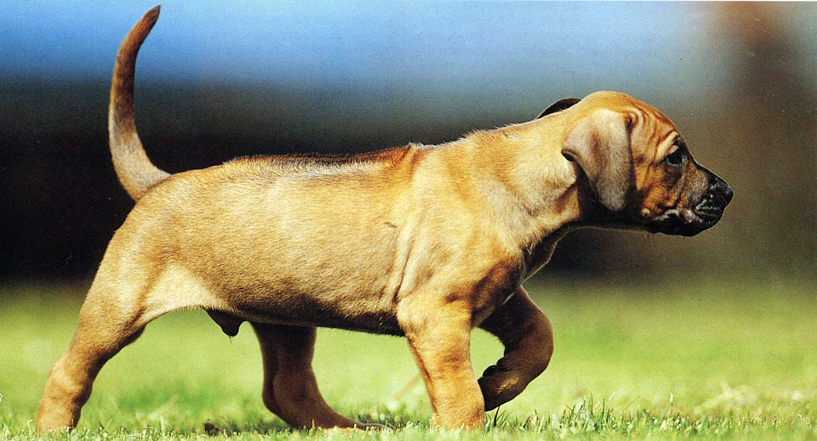
Your ridgeback pup will need minumum grooming: a session with a bristle brush will suffice to keep him looking good
Dignified and intelligent, the Ridgeback can be aloof with strangers. Ridgeback can still excel in agility, tracking, flyball, lure coursing and all other activities that his perfectly ridged sibling can, so if your aim is purely to own a Ridgeback as a companion, it would be well worth discussing giving a home to a ridgeless puppy with a reputable breeder.
Health & welfare
The Rhodesian Ridgeback is generally a hardy and tough breed with few breed-specific problems. The one most prevalent is usually detected soon after birth and eradicated through euthanasia as it can be debilitating in later life. This is the dermoid sinus which is present in some Ridgeback puppies. It is effectively a tube of hair, with an opening through the skin, growing into the dog and sometimes reaching the spine. Although usually found on the back, the dermoid sinus can appear elsewhere on a puppy’s body and experienced breeders will be able to detect it by simply lifting the skin and feeling underneath for any unusual tube-like formations.
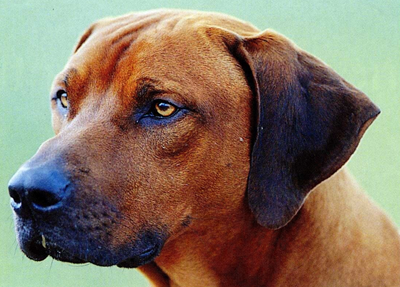
Dignified and intelligent, the Rhodesian Ridgeback can be aloof with strangers
There is an incidence of hip dysplasia in Rhodesian Ridgebacks, but nothing like as high as in other breeds. It is worth discussing the hip scores of a puppy’s parents with the breeder as this will be a good indication of the puppy’s future hip status. Sadly, the majority of Ridgebacks who find themselves in a rescue situation do so through no fault of their own. It is generally caused by a lack of understanding by some owners rushing into buying a puppy without having researched the breed. Consequently many Ridgebacks who come into rescue will be adolescents who have not been given direction as youngsters, and these will be full blooded headstrong dogs in need of rehabilitation and much more patience than normal.
Giving a home to a rescued Ridgeback can prove very rewarding when the new owner appreciates the challenge ahead and is prepared to devote much time and energy into reforming what has been written off as a hooligan i but it can be done. Our thanks go to Jack Selby of Eilack Rhodesian Ridgebacks, Newark, Nottinghamshire, whose dogs are pictured in our feature.
Brace, A.(2003, 12) The Rhodesian Ridgeback,
Your dog, December 2003
